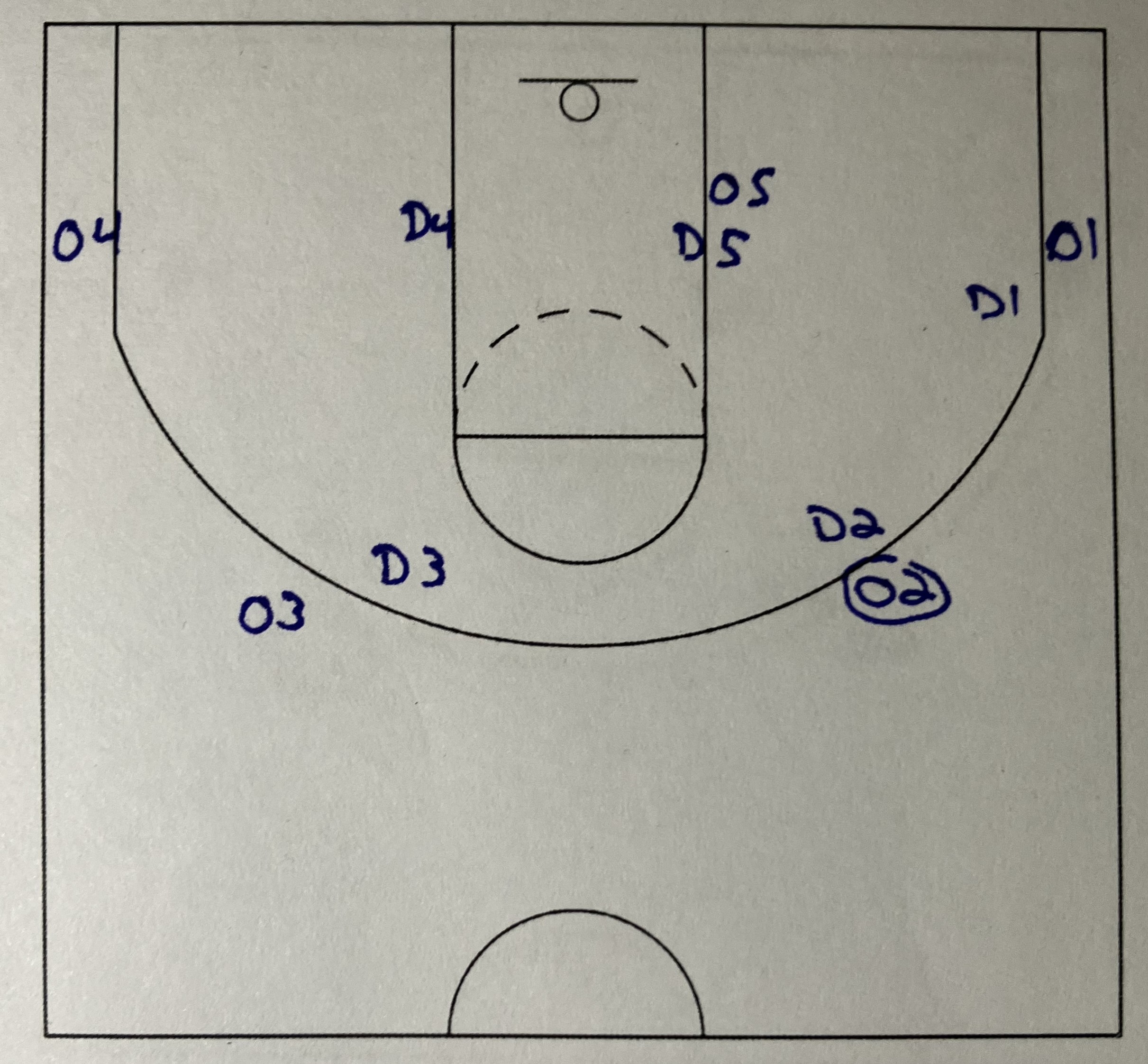What is a 2-3 Matchup Zone?
A 2-3 Matchup Zone is a hybrid defense that is half man-to-man defense and half 2-3 Zone defense. The defense is built on man-to-man principals for each player but instead of following their man the players stay in a certain zone on defense. The position of the 5 defenders does not change. The court is sectioned off and each defender stays in their zones. However, each defender essentially plays a man-to-man defense with the offensive player in their zone.
Advantages of a 2-3 Matchup Zone
1) The main advantage is the ability to keep the guards out in front of the defense and the post players in the back of the defense closer to the basket. This can keep a slow, tall post player in a position right next to the basket. They will never have to come out and guard the perimeter. Likewise, if you have a really small guard then you can keep them out in front of the defense, and you do not have to worry about the other team posting them up. The 2-3 matchup zone prevents the offense from being able to take advantage of the defensive players weaknesses.
2) The second advantage of the matchup zone is the ability of the defense to continue to play defense with man-to-man principals while playing in a zone. When you watch the NCAA tournament in March, take note of how many teams play zone defense. Very few and the teams that do normally are only playing a zone defense for a very short period of time. Man to man defense is the best defense to play if you want to be a great team.
But some teams and players struggle with staying with their man in a straight man to man defense. You may be playing against better offensive players than you have defensive players. How can you counter the offensive’s superiority? By simplifying the defense with a matchup zone concept.
This matchup zone concept gives the defense the ability to continue playing man defense but helps to restrict the amount of floor each player has to defend. You still have the benefits of the man-to-man defense while helping to reduce some of the positioning issues that some teams and players have in trying to guard man to man.
3) The last main advantage is being able to hide the weak defenders within the confines of the zone. The offense is unable to isolate a bad defender and attack them. Since the defense stays in their zone and should always have help right behind them, it makes it harder for offenses to take advantage of a mismatch.
A matchup zone also can confuse an offense and makes it hard for them to score. Since the 2-3 matchup zone is both a zone and man, a man offense might struggle because the defense never gets out of alignment. Also, a zone offense could struggle because the on the ball defense is still man so the spacing of the offense has changed from a true zone defense.
Disadvantages of a 2-3 Matchup Zone
1) The biggest problem with a matchup zone is the ability to communicate between the players. Since the defense is constantly passing offensive players back and forth as in who each defender is responsible for guarding, a lack of communication causes major problems. A loss of communication can lead to the best offensive player running loose and getting wide open. The defense must be in a constant state of talking to each other. Players can struggle with having to talk on defense. Once learned this is not as big of an issue, however, the players must continue to talk every possession or the offense can get an easy basket.
2) The next big disadvantage is the ability of the offense to determine matchups. Most teams want their best defender guarding the other team’s best player. However, in a matchup zone the positioning of the offense determines who is guarding who. So teams can pick out the weakest defender and position themselves so their best player is going to be guarded by that weakest defender. If done correctly by the offense, the defense will always be at a disadvantage by having the worst defender guarding the opponent’s best offensive player.
3) The reliance on being able to guard 1 on 1. The easiest way to beat a matchup zone is with dribble penetration. Since the defense is in a constant state of morphing to match the offense, the rotation of the help side defense is never in the best spot. If the defenders cannot guard 1 on 1 and keep the ball out of the middle of the zone then the offense will be able to get any shot they want. If the offense can force the defense to guard 1 player with 2 defenders then somebody will be left open. Dribble penetration is the biggest issue when using this defense.
Positions of a 2-3 Matchup Zone
You can see the positioning of the defenders of a regular 2-3 zone here. This will give you an idea of the same positioning out of the 2-3 matchup zone. However, the positions of the defense will be changing to “match” the offense. If the offense has 4 players on one side of the floor then 4 defenders should be on that side or at least in a midline position. If all 5 players on offense are on the same side, then all 5 defenders should matchup and be on that side as well. The players should start in a spot but then the positioning of the players after the initial setup should mirror the offense. Therefore, there are no “real” positions of a matchup zone.
Trapping in a 2-3 Matchup Zone
Since there are no real positions of the matchup zone, the ability to trap is very limited. Every defender should be in a constant state of moving to mirror the offense. Since everybody is always moving the ability of the defense to setup and trap is greatly reduced. The one big trapping possibility is in the corner. If the defender guarding the passer follows the pass down into the corner then a trap can be formed. The key to this is having the next defender rotate around to prevent a quick and easy pass out of the trap and make the defender return right back to his man without getting a good trap. There are good things about the matchup zone but trapping is not one of them. Trapping out of a 2-3 matchup zone is difficult and risky. I would not advise except maybe once a half or once a quarter maximum. It could surprise the offense and lead to a turnover or it could lead to an easy layup.
Personnel Needed for a 2-3 Matchup Zone
In an ideal situation, all players would have very high basketball IQs. It is more of a thinking defense than most of the other defenses that can be played. Players need to be able to think and process the information the offense is giving them and reaction correctly to their movements.
The matchup works best with 1 but preferably 2 good tall rim protectors. If you have a good rim protector, the disadvantage of dribble penetration is negated considerably because of the rim protector blocking or altering shots.
The biggest key in the personnel is having all the defenders able to guard every position. I will use a matchup zone when I do not have that one great defender but good defenders across the board. The matchup zone helps to take the pressure off of one defender and spreads it across everybody because each possession could have a different defender being tested by the offense. And since every defender could guard every offensive player, the defenders need to be able to guard every player on offense. Players do not have to be a great defender all the time, only on the possessions they are guarding the ball. And this could be a lot or this could be a little.
Keys of a 2-3 Matchup Zone
1) Communication
2) Communication
3) Communication
When I install the matchup zone, I spend about a week in practice making the defense guard an offense using 1 less man before installing the entire 2-3 matchup zone. This makes the defense constantly rotate towards the ball as well as learning to talk to each other so they are able to defend the offense even though they have one less player. Once they can talk then passing players back and forth and rotating around becomes much easier. In a matchup zone, the players should not be running as much as they do in a man to man because they are passing players to each other. However, their mouths should double their output. They have to talk constantly to notify when players are coming into their areas or exiting their areas. They have to tell their teammates when a player in their area is now moving into their teammates area. The key to the matchup zone is the ability of the players to be able to talk to each other.
Youth Basketball
I would not recommend using a matchup zone in youth basketball. This is a defense that I would say is a high school and up defense. The thinking involved to execute it well is usually not developed until players have reached high school. I would stay to a regular 2-3 zone rather then ever using a matchup zone. It takes a lot of time to learn and a lot of basketball intelligence to run. Most players are not developed enough to understand all the little adjustments that have to be made on the fly without the assistance of the coach.
Conclusion
I like the 2-3 matchup zone at the high school level but not before. I like the matchup zone because it keeps all of your man to man principals in place. The only difference between the matchup zone and man to man is the constant switching that has to take place between the defenders to the offensive players. At the high school varsity level, this is usually the 2nd defense I install. I install man to man first and then put in the 2-3 matchup zone. I will run man to man unless we cannot guard an opposing team 1 on 1. Then I will switch to the matchup. This keeps almost all of the same principals but just adjusts everything to a zone concept. This simple adjustment for whatever reason has proved to be successful. Like I said the hybrid setup can cause the opponent to overthink their offense which helps to benefit the defense.




4 thoughts on “2-3 Matchup Zone Defense Guide”